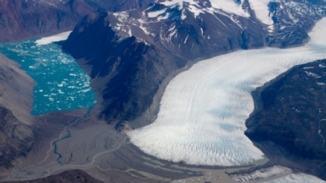
格陵兰融冰使海湾更为肥沃
Greenland's Meltwater May Fertilize Fjords with Phosphorus
格陵兰融冰使海湾更为肥沃
Greenland's glacial rivers may flush some 400,000 tons of phosphorus into ocean waters—on par with the Mississippi or the Amazon.
格陵兰冰川融水可能会将40万吨的磷元素冲入大海。该总量与密西西比河和亚马逊河为同一级别。
撰文/播音 克里斯托弗·因塔利亚塔 (Christopher Intagliata)
翻译 Meatle
审校 邰伦玥
The massive ice sheet topping Greenland is losing nearly 300 billion tons a year to melting, according to NASA estimates. And all that meltwater means rising seas. But it's also dumping huge amounts of nutrients and minerals into Arctic waters.
根据美国航空航天局(NASA)的估算,格陵兰冰盖每年的融冰量接近3000亿吨。这些融化的冰盖造成了海平面的上升。然而,这也意味着巨量的营养物质被倾注进北冰洋。
"The great thing about glaciers and ice sheets, is that they're these big, very heavy systems, and as they move over rock they grind and crush the rock up." Jon Hawkings, a glacial biogeochemist at the University of Bristol in the U.K. "So they expose all these reactive kind of trace components of the rock lattice to the fresh meltwater that's coming in.”
“关于冰川和冰层重要的一点是,它们是如此巨大和厚重的体系,在它们移动的时候,它们碾压并磨研着它们之下的岩石。”英国布里斯托尔大学的(the University of Bristol)的冰川生物地球化学家乔恩·霍金斯(Jon Hawkings)说,“这种作用使岩石中的那些营养物质暴露在冰川融水之下。”
That meltwater funnels rock dust into Greenland's glacial rivers, where Hawkings and his colleagues took their samples. They found that Greenland's rivers are much richer in phosphorus than previously believed. And they estimate that Greenland's glacial rivers may flush some 400,000 tons of phosphorus into ocean waters every year—that’s on par with the amount of phosphorous dumped into the ocean by the Mississippi or Amazon rivers. The findings appear in the journal Global Biogeochemical Cycles. [Jon Hawkings et al, The Greenland Ice Sheet as a hot spot of phosphorus weathering and export in the Arctic]
冰川融水将岩石粉尘冲刷到格陵兰冰川河内。霍金斯和他的同僚就在冰川河取得了他们的研究样本。他们发现,冰川河中的磷含量比他们此前认为的要高很多。他们估算格陵兰冰川融水可能会将40万吨的磷元素冲入大海。该总量与密西西比河和亚马逊河的磷含量是同一级别。这项研究发表在《全球生物地化循环杂志》(Global Biogeochemical Cycles)上。
All that extra phosphorus could be fertilizer for ocean life. "It's an essential nutrient for phytoplankton, who are the guys on the bottom of the food chain. So it's really, really important for life. And life can't exist without it." And this process—glaciers grinding rocks, then melting and flushing those nutrients to sea—it’s not the first time it's happened. In fact, the authors speculate that during the last extreme ice age—the so-called "snowball Earth," some 700 million years ago—all this phosphorus runoff may have caused a bloom in ocean life. A bloom that may have ultimately oxygenated the planet...and paved the way for organisms like us.
这些额外的磷元素将会成为海洋生物的养分。“磷元素是浮游植物必须的元营养素,而浮游植物则作为食物链底层支撑着整个生态圈。因此磷元素对于生命来说相当重要。生命不能离开磷元素。”这种冰川研磨岩石,冰融水将营养物质冲入大海的过程并不是首次发生。实际上,作者推测在上一个极端的冰河时代中——约7亿年前的“冰雪地球” (“snowball Earth”,成冰纪),同样的磷元素溪流可能带来了海洋生物的旺盛增长。这种增长可能最终导致了地球大气的富氧化,并为向我们一样的复杂生命体铺平了前路。
未经书面许可任何人不得复制或镜像
京ICP备11000850号-1
 京公网安备11010502039775号
京公网安备11010502039775号 信息网络传播视听节目许可证0111611号
国家科技基础条件平台

















